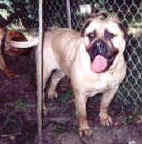 BullmastiffInfo.org:
Please explain what exactly "MoKan Bullmastiff Rescue" is. What does
"MoKan" stand for? BullmastiffInfo.org:
Please explain what exactly "MoKan Bullmastiff Rescue" is. What does
"MoKan" stand for?Johnsen:
MoKan stands for Missouri Kansas
Bullmastiff Rescue. As I live in Kansas City, I take rescue dogs
from both States. MoKan Bullmastiff Rescue is an organization that
strives to help any bullmastiff in need...whether it be re-homing
it, working with the owners on behavioral training, providing
lost/found assistance, or any other way help is needed. In some
circumstances a stipend is available for assistance with the cost of
spaying and neutering of bullmastiffs and bullmastiff mixes.
BullmastiffInfo.org: What prompted the creation of MoKan
Bullmastiff Rescue?
Johnsen: I have rescued
dogs as long as I can remember. When I got involved in animal
sheltering, I realized I needed to limit the animals that I took in.
My family has been involved with bullmastiffs for three generations
now and the bullmastiff was the obvious choice. At first I was
appalled that there was even a NEED for bullmastiff rescue...didn't
everyone love them like I did? I'm not so naive now. When I found my
first rescue dog through a newspaper ad, I called up the National
Coordinator and said, "OK, I've got a rescue dog, now what?"
Thankfully, she was very patient with me!
BullmastiffInfo.org: Describe your first rescue case.
Johnsen: My first rescue
was a fawn girl named Zuni. Zuni was a young girl that was
advertised in a local paper. Part of the ad stated, "Will fight
small dogs." This concerned me as we have a large dog-fighting
contingency in my area and I didn't want this girl to fall into the
wrong hands. I called the people, expressed my concerns, and gave
them tips for placing Zuni in a safe home. About 3 days later, I got
a phone call asking me to come get her, as they were getting calls
from the most awful people on the ad. When I got her I found a dog
who was very sweet to people, but VERY animal aggressive. Her
registration papers and the USDA papers from her breeder accompanied
her. Under the "Notes" section of the USDA papers was the following:
"Under no circumstances will the breeder take back the puppy or give
a refund. All sales final." This was a definite red flag! While Zuni
proved to be a lovely dog when other animals weren't around, she was
a time bomb. I fully believed she would go THROUGH a person to get
to another animal. Because I didn't want to be responsible for her
injuring a person through her animal aggression (or an animal for
that matter), I humanely euthanized her. It took three weeks, with
the help of the National rescue coordinator, to come to this painful
decision. My first rescue was definitely not easy!
BullmastiffInfo.org: As Bullmastiff ownership has exploded, so
has the number of Bullmastiffs coming into the Bullmastiff Rescue
program. What factors do you think are the main reasons for such an
increase of Bullmastiffs coming into Bullmastiff Rescue?
Johnsen: I think there are
a number of factors involved. The easiest to explain is that I think
there have always been bullmastiffs in need. I think every year the
rescue community gets much better at getting the word out. The
general public is aware of rescue as an option to a shelter; the
shelters are becoming more aware of rescues that are frequently able
to put time and resources into a dog that they can't.
Another factor has happened for ages...we simply live in a "throw
away" society. I really don't believe the people that surrender dogs
to us generally intend to keep the dog until it dies of old age.
I've heard every reason for surrender in the book. The most common
is "moving." The stupidest (so far anyway) is "just
redecorated...dog no longer matches furniture." I also get a fair
number of "dog grew too big."
Still another factor is breeder irresponsibility. There would be
much less bullmastiffs available for poor quality homes, puppy
mills, and shelters if the breeders of those dogs did their job. I
firmly believe that a breeder is responsible for that puppy until
the day it dies. If you have a litter of five puppies, I believe you
should always keep in the back of your mind what you would do with
those 5 dogs should they all lose their homes at the age of 10
years. That's your job. Part of that job is staying in touch with
your puppy buyers and being there to answer training, behavioral and
other questions. Bullmastiffs can be a trying breed (particularly an
18 month old intact male!!!) Owners need to be prepared for this.
Also, breeders should be requiring that all dogs going to pet only
homes be spayed or neutered. Limited registration is great, but only
goes so far. It doesn't prevent that dog from hooking up with the
dog down the street. I get plenty of bullmastiffs in to rescue who
were not registered puppies. Owners also need to be counseled by the
breeder in the benefits of puppy classes and obedience classes. I
have people tell me all the time they've trained a puppy before, so
they don't need classes...they've missed the point: the classes are
for socializing and for getting the puppy and the owner on the "same
page." They are not to teach the owner exclusively.
Lastly, I think an important factor is socialization. I once heard a
good rule of thumb (if I remember right this comes from Mona
Lindau-Webb): a bullmastiff should meet 100 people by the time it is
six months old. This is a WONDERFUL rule. If you have an owner that
committed to a dog, chances are they'll be committed to handling any
issues that arise. I'm sure I left something out; as you can tell
it's not a quick fix.
 BullmastiffInfo.org:
Is there anything that the public can do to help rectify these
factors to help reduce the number of Bullmastiffs being abandoned? BullmastiffInfo.org:
Is there anything that the public can do to help rectify these
factors to help reduce the number of Bullmastiffs being abandoned?
Johnsen: 1) Educate
themselves thoroughly before getting a dog 2) Spay or neuter the dog
unless they are planning on learning everything needed to show
and/or breed 3) If they aren't willing to deal with a 10 year old
dog with gas, that slings drool, that doesn't like the neighbor
dogs, and that sometimes have overwhelming health problems, don't
get a bullmastiff 4) Wait to get a dog until they have everything
ready...puppy classes, time to socialize properly, enough money for
the best diets and veterinary care, etc.
BullmastiffInfo.org: In your location, dog auctions and
puppymills are fairly common. Please explain what a dog auction is.
Johnsen: Dog
auctions are vile places in which dogs of every breed imaginable are
auctioned off in the style of the livestock auctions. They are
mostly attended by brokers and people who breed dogs to sell to
brokers. It's the way the "Commercial breeder" uses to trade stock
back and forth for unrelated lines, etc. It's also a way that a
puppy miller will get rid of an unwanted dog. It's run as a regular
auction, the exception is that there is very high security at them.
You pass through security (often the local sheriff who is armed) and
register to bid. They bring dogs in in catalog order. The small dogs
are held up in various positions and the large dogs are drug in by
leashes (it's rare to see one that's leash broken). "Faults" are
pointed out (hernias, missing eyes, missing teeth, scars, etc).
People can go up and check to see if the dog is in heat, etc.. The
dogs are generally freshly groomed. The females are frequently
pregnant or have litters of puppies with them. The dog goes to the
highest bidder. You pay for the dog and an auction house employee
brings it to your vehicle after check out. The largest auction house
in Missouri frequently has drawings for door prizes, vendor booths,
and concessions.
BullmastiffInfo.org:
Are Bullmastiffs typically present at these auctions? What
are some of the reasons these Bullmastiffs have been put up for bid?
Johnsen:
I wouldn't say
they're typically present, but they're not terribly unusual either.
This last season (2001) there were approximately 10 that came
through on auction flyers. The year before there were approximately
30. Those are very approximate figures, however, because there are 3
other auction services that I'm not able to monitor closely yet.
The overwhelming reason is that the animal has not bred well in the
past or they are not expected to breed well in the future. It is a
money making proposition, and if they don't "produce" they don't
stay.
BullmastiffInfo.org:
Should a Rescue Service invest funds in acquiring these
Bullmastiffs from the auctions? Why or why not?
Johnsen:
In my PERSONAL opinion, yes...to a point. There
are some rescue groups who pay $1000s of dollars for a single dog to
come out of an auction situation. This does NOTHING but tell the
millers that this is a money making breed, and they'll get more.
They are now going overseas for rarer breeds (Spanish Mastiffs,
Coton de Tulear, etc) and can get a hold of ANY breed. However, my
personal cut off is $200. If I see a bullmastiff auctioned for less
that $200 and I have the personal money to buy it, I have no problem
with that. I do NOT use American Bullmastiff Association Rescue
funds for this...I would use my own personal funds. I chose $200,
because I believe that any miller would have at least that much
invested in a bullmastiff...between food and original purchase price
if nothing else. This way I don't feel like they are making money,
and I can get the dog into a better situation. In some cases where
the dog is healthy, I can pass part of the purchase price on to an
adopter. More often that not, however, the dog is not healthy. It is
easy to say to not financially support the auctions. I ask anyone
who says that, though, to accompany me to an auction and watch a
bullmastiff get sold like livestock. It is not easy to watch at all.
....continue.... |
 BullmastiffInfo.org:
Please explain what a puppymill is. BullmastiffInfo.org:
Please explain what a puppymill is.
Johnsen:
My PERSONAL
definition is any person who breeds primarily for monetary gain.
BullmastiffInfo.org: Pet shops often acquire their puppies from
mass production facilities. When a shopper sees a puppy in a pet
store - should they buy that puppy? Why or why not?
Johnsen:
Absolutely not! The
puppy is bred at the breeder. The breeder has an average cost of
about $200 in each litter (according to what I've heard them tell me
at auctions). Each bully puppy brings around $450 when sold to a
broker (current year pricing). The broker then sells it to a pet
shop, who sells it to a member of the public...often for $1200 or
more. In every step along the way these people have made money
(because they've taken short cuts everywhere). When the puppy gets
sold to the consumer the message is, "Breed more, we have a market
for them." I refer you to Candy's Story to find out where they come
from.
BullmastiffInfo.org: Would buying this puppy from the pet shop be
considered a form of "rescue"? Why or why not?
Johnsen:
Not in my opinion.
It's a form of poor judgment. I know it's hard to see that puppy sit
in the window...I've watched them myself. However, we will NEVER
stop the supply until there is no more demand. Simple economics 101.
 BullmastiffInfo.org:
When a Bullmastiff comes into the Rescue program, the organization
rarely knows anything about the dog in regards to physical health
and temperament until they actually live with the dog for some time.
This still does not guarantee however, that everything can be found
out about the dog before placement into a permanent home. Therefore,
there is a liability risk when placing rescued Bullmastiffs in homes
where someone gets hurt. What can the volunteer that placed the dog
do to protect themselves beforehand in the case of a lawsuit? BullmastiffInfo.org:
When a Bullmastiff comes into the Rescue program, the organization
rarely knows anything about the dog in regards to physical health
and temperament until they actually live with the dog for some time.
This still does not guarantee however, that everything can be found
out about the dog before placement into a permanent home. Therefore,
there is a liability risk when placing rescued Bullmastiffs in homes
where someone gets hurt. What can the volunteer that placed the dog
do to protect themselves beforehand in the case of a lawsuit?
Johnsen:
The best thing is as thorough of a
behavioral/health screening as possible on the rescued dog. The next
step is a screening of the home (just as thorough). I NEVER cut
corners on this...every home fills out an application for adoption,
has references checked, I talked to their vet, and in all but rare
exceptions a home visit is done. In those rare exceptions, at least
a drive by fence check is done. I have been very lucky to have
received cooperation from rescuers in every corner of the United
States who have been willing to help with home visits. The next step
in the process is a good Adoption Contract. The owners must
understand that this pet is now their pet and they are legally
responsible for it's actions. The last step is follow up with the
adopters. I will call occasionally for the first year of adoption. I
always send out a Christmas letter with personal notes asking how
the dog is doing. If I don't hear from someone at least annually, I
try very hard to re-establish contact to make sure I've not been
caught off-guard. Some people mistakenly think all of this contact
is because I want the dog back...on the contrary...all of this
contact is because I do NOT want the dog back. I want each of my
foster dogs to die happily in the home I placed them in. I want to
be able to sleep at night knowing that I placed that dog in it's
final home.
 BullmastiffInfo.org:
Most Rescue Organizations exist for the purpose of doing honest
rescue work. However, as with any other industry, there are some
unscrupulous rescuers as well. What can a family seeking to adopt
from a Rescue Organization do to avoid dishonest rescuers? BullmastiffInfo.org:
Most Rescue Organizations exist for the purpose of doing honest
rescue work. However, as with any other industry, there are some
unscrupulous rescuers as well. What can a family seeking to adopt
from a Rescue Organization do to avoid dishonest rescuers?
Johnsen:
Use common sense! To
protect myself, I do not give out my address for people to come see
dogs (you'd be amazed how mad some of them get when they are turned
down for adoption), however, I am very forthright in other arenas. I
will tell anyone the negative traits of that particular dog. If a
potential adopter gets the feeling from the rescuer that this dog is
totally perfect, chances are there is something they're not telling
you (although there are the very rare easy rescues!). If you are
concerned ask the rescuer for phone numbers of people they've
previously adopted to and call to ask them their opinion of the
process. Also, call local shelters or the National Rescue
Coordinator for the breed to see if the rescuer is known and
respected. I would also call a local veterinarian if you are getting
red flags. My personal pet peeve is a rescuer who doesn't pay their
vet bills! Lastly, if you're still concerned, call another rescuer
(even of a different breed) in the area...they frequently know about
the practices of each other.
BullmastiffInfo.org: What is the adoption fee for adopting a
Bullmastiff from MoKan Bullmastiff Rescue? How is the adoption fee
determined?
Johnsen:
The adoption fee
ranges from $200 to $300, depending on the medical bills of the dog.
Adoption fees go towards sterilizing, microchipping, vaccines,
worming. Additionally the dogs are started on housebreaking and
obedience training. Dog food, gas, stamps, copying costs, and many
other details are donated by the foster home.
BullmastiffInfo.org: For families interested in adopting a
Bullmastiff from MoKan Bullmastiff Rescue. what steps do they need
to take in order to acquire a rescued Bullmastiff into their
household?
Johnsen:
The first step is to fill out an application
for adoption (available either on line or I can mail one to you).
The next step is reference checks and a home visit. Finally, I
strive to match the family and the dog for the best match.
BullmastiffInfo.org: What expectations should these adopting
families expect from both the Bullmastiff they are adopting as well
as from the Rescue Organization they are acquiring the Bullmastiff
from?
Johnsen:
It's very difficult
to say what they should expect from a rescued bullmastiff...so much
depends on the situation the dog came from, which is frequently
unknown. As a general rule though, I find that the dogs are on their
best behavior for 3 weeks. Then they push the limits a bit. That's
when the owner must enforce the rules. They're generally pretty good
(provided rules were enforced) until about 3 months into the home
when the same thing happens again. I call these the "honeymoon"
periods. I don't know if other rescuers notice this as well, but I
hear of it time and again from my adopters.
From the rescue organization you should expect honesty, an intense
application process, and support after the adoption for the lifetime
of the dog. You should also expect that should the adoption ever
fail, the rescuer will take the dog back.
BullmastiffInfo.org: How can people contact MoKan Bullmastiff
Rescue?
Johnsen:
MoKan Bullmastiff
Rescue can be reached at:
Email:
bmfrescue@aol.com
Phone: 816-455-5401
Address: P.O.Box 11042
Kansas City, MO 64119

BullmastiffInfo.org:
BullmastiffInfo.org would like to
personally thank Kelli Johnsen for taking the time to share her thoughts and experience with our readers! If you would
like more information about MoKan Bullmastiff Rescue, please contact
Kelli Johnsen at
MoKan Bullmastiff Rescue
President
Kansas City, Missouri
Email:
bmfrescue@aol.com
 |